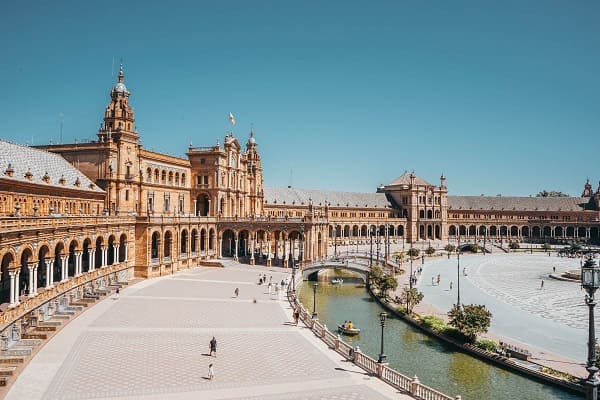The picturesque fishing neighborhood of Triana, located on the banks of the Guadalquivir River, offers a unique experience full of history, culture and life. This neighborhood is rooted in gypsy roots, it is the fundamental cradle of pottery and the place of residence of renowned artists. Discover what to see and do in the Triana neighborhood in this article and enjoy its wonders while you explore this charming place.
Triana Bridge
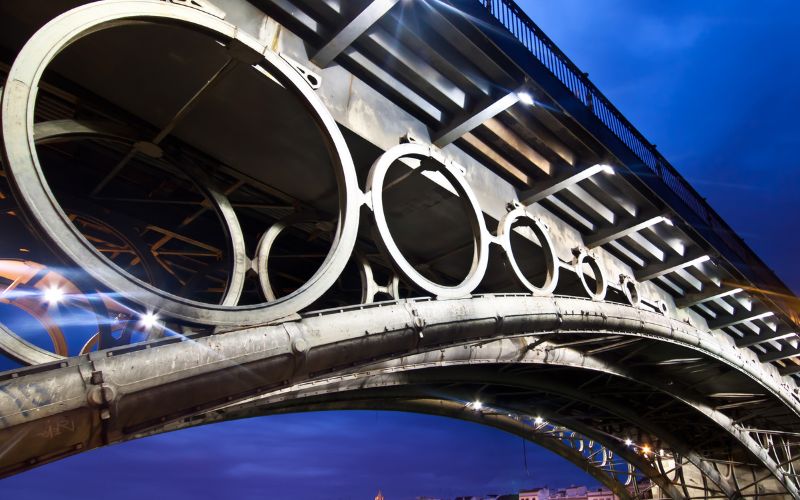
Triana, that charming neighborhood of Seville, is considered almost like an independent republic, a kind of enclave with an identity so marked that its inhabitants, the Trianeros, when crossing the Puente de Isabel II, commonly known as Puente de Triana, express that they are going to "Seville" as if they were crossing to a different city, although they are still in their own home.
The Elizabeth II Bridge, although officially named in honor of the queen, is more recognized by the name of the neighborhood that connects to the main city. This bridge is the oldest in Seville, but its history goes back even further: in its place, there was a bridge of boats ordered to be built by an Almohad caliph, which linked Seville with Triana and was in operation for approximately seven centuries, from 1171 until 1852. It was only then that the structure we know today was erected.
The bridge, in addition to being a vital link between Triana and the rest of the city, offers those who cross it spectacular views of the Guadalquivir River and the landscape that extends on the opposite bank. Its rich history, going from an old boat bridge to the architectural majesty that it is today, makes it an emblematic icon that represents the historical connection between these two iconic Sevillian districts.
This emblematic crossing is not only a place of passage, but a silent witness to the evolution and transformation of life in Seville and Triana over the centuries.
Little Chapel of Carmen
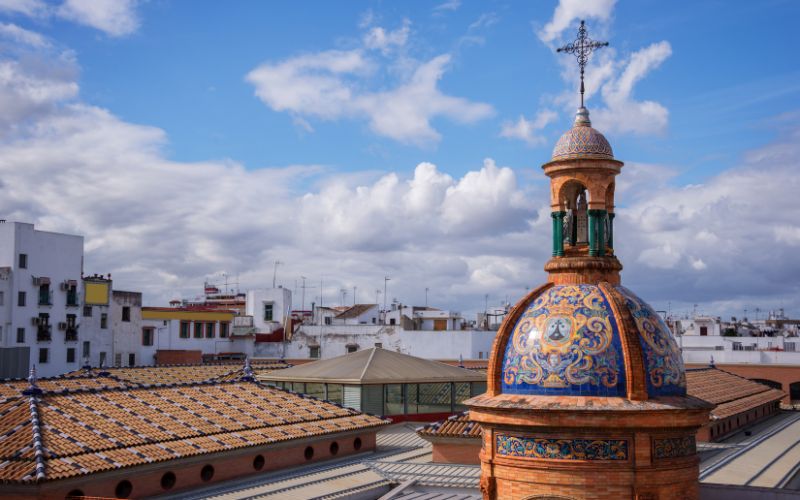
The Capilla del Carmen stands as one of the most charming corners of Triana, captivating those who discover it after crossing the iconic Triana Bridge.
Located near the food market, this small architectural gem is reminiscent of the Plaza de España in Seville due to the chromatic exuberance of its dome. The curiosity lies in the fact that both structures share a creator: Aníbal González Álvarez-Ossorio, a mastermind who left his mark on several emblematic points of the city.
The Capilla del Carmen, more than a simple religious building, represents an architectural fusion between history, faith and art. Its design and details invite visitors to immerse themselves in the creativity and mastery of its architecture.
Open to the public from Monday to Saturday, from 10 a.m. to 1:00 p.m., the chapel offers the opportunity to enter its interior and be surprised by the beauty of its ornamental details and the tranquility that is breathed in its environment. .
Triana Market
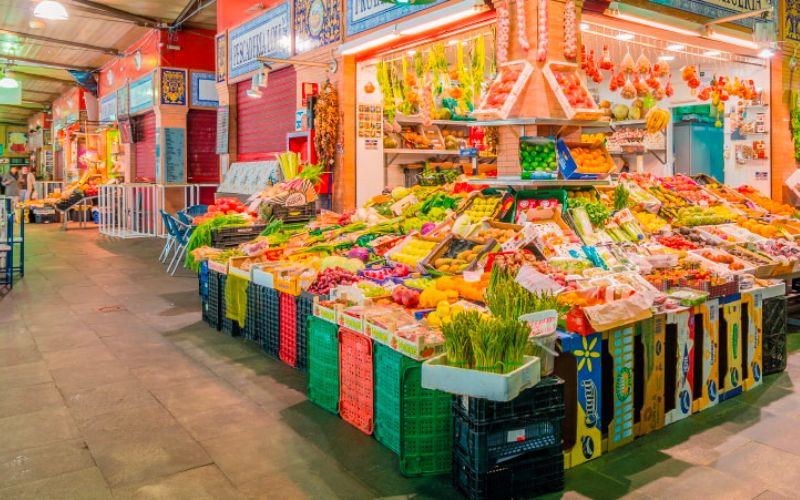
The Triana Market, an unmissable place to enjoy local gastronomy and the tapas experience. In addition to its wide culinary offer, the market is an ideal space to walk around and discover typical Sevillian products.
Open from Monday to Saturday, food shops operate from 9:00 am to 3:00 pm, while bars are available from 10:00 am to midnight (Sundays and holidays from 12:00 pm to 5:00 pm) .
A fascinating curiosity is its historical connection: during the renovation for the 1992 Expo, ruins of the ancient Castle of San Jorge were found, dating from the 12th century and seat of the Inquisition since 1481. These ruins are accessible free of charge on the ground floor.
The Triana market is much more than a place to eat; It is an opportunity to explore, admire and enjoy the rich history that this emblematic space in Triana houses.
The Hope of Triana, its Virgin
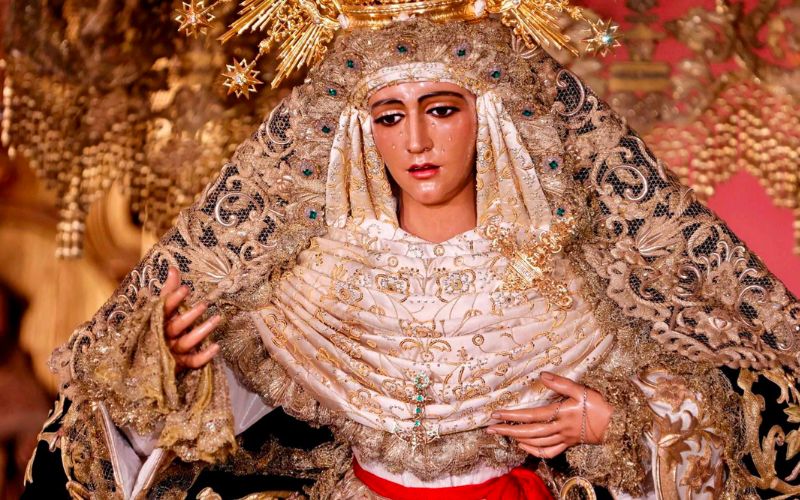
The Virgin of Hope of Triana is a fundamental icon for the people of Triana. This religious figure, represented in prints and photographs in emblematic bars, is the heart of the neighborhood's devotion.
If you visit the Virgin, see her cloak embroidered with the anchor symbol. Access the devotional treasure through the store, open daily during chapel hours, where you can see the mounted step, the Virgin's cloaks, jewelry and elements related to Holy Week and the devotion to this image.
The Brotherhood of La Esperanza de Triana had an interesting historical background. Before 1755, it resided in the church of Santa Ana, but due to the Lisbon earthquake, it was forced to look for a new location. After having visited various churches in Triana, in 1759 it was decided to build the Mariners' Chapel, its current location.
On Calle Pureza, 48, right in front of this church, there is a store that offers embroidery from Triana's Holy Week and merchandising items from the neighborhood, perfect for carrying a souvenir in your luggage.
Devotion to the Virgin of Hope of Triana and its history are aspects deeply rooted in the identity of this Sevillian neighborhood, showing its rich religious and cultural tradition.
Triana Ceramics Center
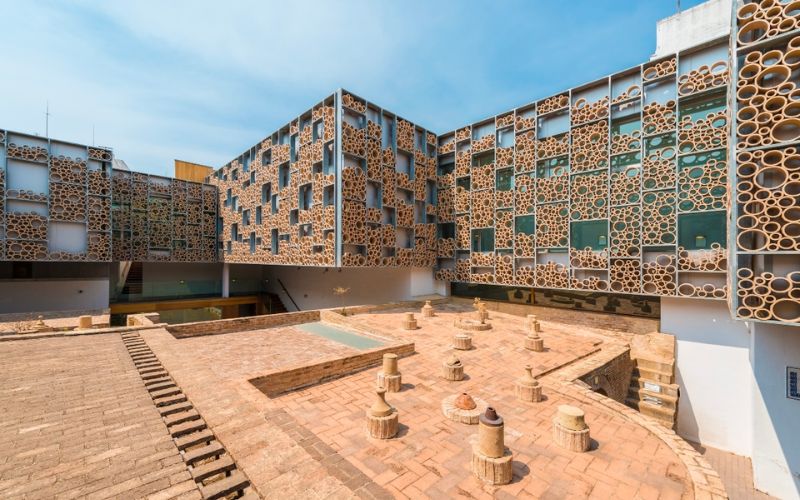
The Triana Ceramics Center, established in 2014, stands out as a key point to explore and understand the rich pottery tradition of the iconic Sevillian neighborhood. Its main objective has been to highlight the spatial, ethnological and anthropological value of Triana.
All elements of the center are presented in their original context. The restored ovens and the preservation of the routes and interactions between the various professions that coexisted in this space offer an authentic experience. With two floors, the place houses a permanent exhibition, visits to archaeological remains, a specialized documentation center and a space for interpretation and guidance of the neighborhood's tourist itineraries.
The strategic location of the CCT is not random: it is located on the pottery complex that was once the headquarters of the historic company Cerámica Santa Ana-Rodríguez Díaz SL
The Triana Ceramics Center not only preserves pottery history, but also offers a window into the neighborhood's industrial past, allowing visitors to immerse themselves in its cultural heritage and understand the importance of ceramics in Triana's identity.
Betis Street
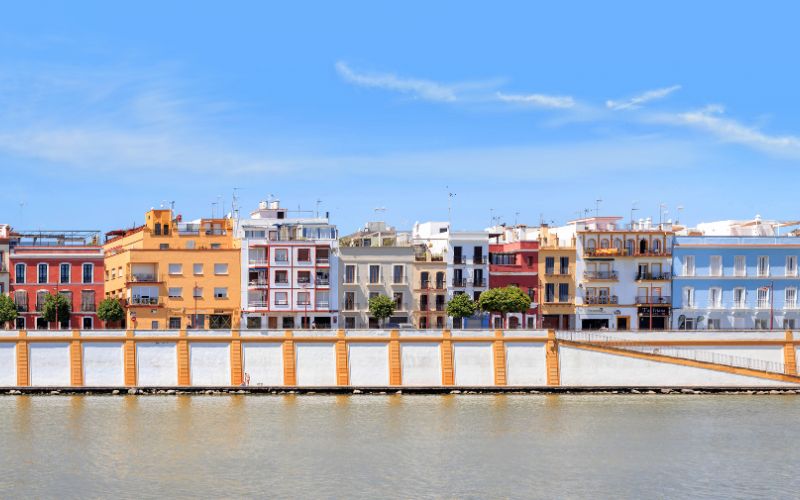
The colorful facades make this Triana street an iconic place in Seville, being one of the most photographed. In addition to its visual charm of its colorful houses, the street is known for its bars and terraces with views of the Guadalquivir.
On this street, the lively atmosphere combines with the picturesque architecture, attracting both locals and tourists in search of authentic experiences and panoramic views of Seville. We recommend you pay attention to the House of Columns and its beautiful baroque façade. As for hotels and apartments to stay in, without a doubt the best option is Casa de Triana, with a spectacular Sevillian patio and unparalleled decoration finishes.
Alley of the Inquisition and Paseo de la O
Next to the Castle of San Jorge, there is a narrow 35-meter alley that connects with the Paseo de la O. This historic passage used to be the route to transport prisoners to their trials or executions at the stake. In contrast to the somber atmosphere of its past, the Paseo de la O, on the opposite bank, offers a calm and peaceful experience along the river.
Currently, a complete remodeling of Paseo de la O is planned, led by Ignacio Laguillo's studio. The project aims to reorganize this section of the riverbank and improve its connection with Betis Street. The aim is to provide the place with shading, green areas, viewpoints and meeting and celebration spaces, transforming it into a more welcoming and attractive meeting point.
Flamenco show in Triana
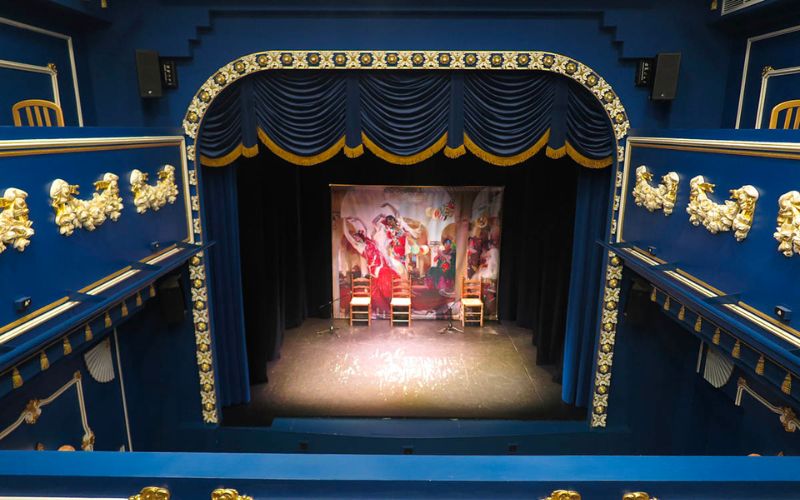
Triana, known as the capital of flamenco, has been the birthplace of renowned singers and dancers such as Antonio Canales or Isabel Pantoja. The art of flamenco flows through every corner of this Sevillian neighborhood, impregnating its streets with an incomparable passion.
Attending a flamenco show like the one at the Triana Flamenco Theater for 25 euros is an excellent option to immerse yourself in the essence and energy of flamenco art in its place of origin.
San Jacinto Street
A few steps from Plaza del Altozano and Calle Betis, you will find one of the most important streets in Triana: San Jacinto Street. This street, recognizable for its length of more than 600 meters, is a nerve center of the neighborhood, full of bars and restaurants with terraces ideal for enjoying a good tapa.
Cervecería “La Grande” is a prominent place in our tapas guide, famous for offering tasty tapas free with your drink. On this street, gastronomy is an attraction that never goes unnoticed.
In addition to its culinary offering, San Jacinto Street is home to important historical buildings in Triana. Among them are the Casa de los Mensaque, a traditional Sevillian house dating from 1900, and the beautiful baroque church of San Jacinto, built in the 18th century. These monuments add a fascinating historical perspective to a visit to this iconic street.
St. Anne's Church
Known as the Cathedral of Triana, the church of Santa Ana is the oldest Christian temple in Seville and has been declared a Site of Cultural Interest.
This church, commissioned by King Alfonso
Inside is the image of the Virgin of Victory, before which the 265 crew members of Magellan's expedition knelt before leaving on their trip to circumnavigate the world. Its presence makes this place essential in the guide of the best places to visit in Triana.
Triana Neighborhood Corrals
Perhaps less known but of great architectural importance in the history of Triana are the neighborhood corrals. Some maintain their original appearance, representing valuable examples of these structures that used to be the heart of community life. The House of Flowers is one of the most notable.
In autumn 2022, the Seville City Council promoted an initiative to visit and highlight these neighborhood corrals. This cultural proposal is interesting for those looking to immerse themselves in these historical spaces.
Conclusion
Exploring Triana is entering the very essence of Seville, enjoying its gastronomy, its music, its architecture and its authenticity, leaving an indelible mark on all those who have the privilege of walking its streets and discovering its secrets. In short, the Triana neighborhood in Seville is much more than a simple tourist destination: it is a melting pot of history, art and tradition. From its streets full of charm and color to its emblematic monuments and cultural spaces, Triana offers a unique experience to its visitors. We hope you have enjoyed this guide on what to see and do in the Triana neighborhood but, If you want to learn more about the history of this emblematic neighborhood, click here.


